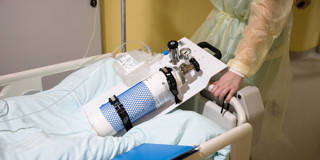Far too many people died from lack of oxygen during the COVID-19 crisis, and far too many are dying unnecessarily today from other conditions because medical oxygen is not routinely available. Now, the global response to shortages that took shape during the pandemic needs to evolve for the long term.
GENEVA – Among the most shocking images from the COVID-19 pandemic were of people gasping for air, unable to breathe, their blood oxygen so severely depleted that some died in ambulances lined up outside hospitals. In wealthier countries, there was a panicked rush to expand ventilator capacity to deal with the surge of people experiencing acute respiratory distress. In countries like India and Kenya, there was an even more desperate scramble to find oxygen cylinders for loved ones. In low- and middle-income countries, nine out of ten hospitals lacked the equipment to provide oxygen therapy.
Seeing people dying for lack of oxygen, the Global Fund to Fight AIDS, Tuberculosis, and Malaria, Unitaid, USAID, and other global agencies took action. Under the umbrella of the Access to COVID-19 Tools Accelerator, we established the Oxygen Emergency Taskforce to coordinate the emergency response, broaden access, and secure supplies. Since then, the taskforce has overseen an investment exceeding $1 billion for oxygen-related needs, primarily via the Global Fund COVID-19 Response Mechanism (C19RM). These funds have gone toward procuring oxygen cylinders and bulk storage tanks, installing oxygen production machines (known as pressure swing adsorption plants), and offering specialized training for health workers.
Tragically, this response came too late for too many people, because the peak of the pandemic coincided with a worldwide shortage of oxygen cylinders. Furnishing a hospital with a sustainable oxygen supply takes many months, given the need to install sophisticated equipment and pipework; and training health workers to provide oxygen safely cannot be done overnight.

GENEVA – Among the most shocking images from the COVID-19 pandemic were of people gasping for air, unable to breathe, their blood oxygen so severely depleted that some died in ambulances lined up outside hospitals. In wealthier countries, there was a panicked rush to expand ventilator capacity to deal with the surge of people experiencing acute respiratory distress. In countries like India and Kenya, there was an even more desperate scramble to find oxygen cylinders for loved ones. In low- and middle-income countries, nine out of ten hospitals lacked the equipment to provide oxygen therapy.
Seeing people dying for lack of oxygen, the Global Fund to Fight AIDS, Tuberculosis, and Malaria, Unitaid, USAID, and other global agencies took action. Under the umbrella of the Access to COVID-19 Tools Accelerator, we established the Oxygen Emergency Taskforce to coordinate the emergency response, broaden access, and secure supplies. Since then, the taskforce has overseen an investment exceeding $1 billion for oxygen-related needs, primarily via the Global Fund COVID-19 Response Mechanism (C19RM). These funds have gone toward procuring oxygen cylinders and bulk storage tanks, installing oxygen production machines (known as pressure swing adsorption plants), and offering specialized training for health workers.
Tragically, this response came too late for too many people, because the peak of the pandemic coincided with a worldwide shortage of oxygen cylinders. Furnishing a hospital with a sustainable oxygen supply takes many months, given the need to install sophisticated equipment and pipework; and training health workers to provide oxygen safely cannot be done overnight.